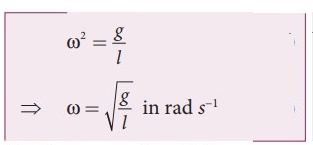Oscillations | Physics - Short Questions and Answer | 11th Physics : UNIT 10 : Oscillations
Chapter: 11th Physics : UNIT 10 : Oscillations
Short Questions and Answer
Oscillations (Physics)
Short Answers Questions
1. What is meant by periodic and non- periodic motion?. Give any two examples, for each motion.
●
Periodic motion: Any motion which repeats itself in a fixed time
interval is known as periodic motion. Examples: Hands in pendulum clock,
swing of a cradle, the revolution of the Earth around the Sun, waxing and
waning of Moon, etc.
●
Non-Periodic motion: Any motion which does not repeat itself after a
regular interval of time non-periodic motion. Example: Occurrence of
Earth quake, eruption of volcano, etc.
2. What is meant by force constant of a spring?
Force
constant is defined as-force
Eg.: Per unit
displacement.
Force
constant = Force / Displacement
Example:
●
Oscillations of a loaded spring
●
Vibrations of a turning force
3. Define time period of simple harmonic motion.
The
time period is defined as the time taken by a particle to complete one
oscillation. It is usually denoted by T. For one complete revolution, the time
taken is t = T.
therefore,
ωT = 2π / T
=>
T = 2π / ω
4. Define frequency of simple harmonic motion.
●
The number of oscillations produced by the particle per second is called
frequency. It is denoted by f. SI unit for frequency is S−1
or hertz (In symbol. Hz).
●
Angular frequency is related to time period by ω = 2π / T
●
The number of cycles (or revolutions) per second is called angular frequency.
●
It is usually denoted by the Greek small letter ‘omega'. ω.
●
Angular frequency and frequency are related by ω = 2π f
● SI unit for angular frequency is rad S−1.
5. What is an epoch?.
The
displacement time t = 0 s (initial time), the phase ϕ = ϕo is called
epoch, (initial phase) where ϕo is called the angle of epoch.
6. Write short notes on two springs connected in series.
●
Consider only two springs whose spring constant are k1 and k2
and which can be attached to a mass m.
●
The results thus obtained can be generalized for any number of springs in
series.
●
For springs in series connection, reciprocal of effective spring is equal to
reciprocal of individual spring.
7. Write short notes on two springs connected in parallel.
●
Consider only two springs of spring constants k1 and k2 attached
to a mass m.
●
The results can be generalized to any number of springs in parallel.
●
For springs in parallel, the effective spring constant is equal to sun of
individual spring constant.
8. Write down the time period of simple pendulum.
●
The angular frequency of the oscillator is

● The frequency of oscillations is
 ,
,
and time period of oscillations is
 .
.
9. State the laws of simple pendulum?.
●
Law of length: For a given value of acceleration due to gravity, the
time period of a simple pendulum is directly proportional to the square root of
length of the pendulum. T ∝
√l
●
Law of acceleration: For a fixed length, the time period of a simple
pendulum is inversely proportional to square root of acceleration due to
gravity. T ∝ 1/√g
10. Write down the equation of time period for linear harmonic oscillator.
●
From Newton's second law, we can write the equation for the particle executing
simple harmonic motion
m
= d2x / dt2 = kx ;
d2x
/ dt2 = − (k/m) x
●
Comparing the equation with simple harmonic motion equation, we get,

●
Natural frequency of the oscillator is  Hertz
and the time period of the oscillation is
Hertz
and the time period of the oscillation is  second.
second.
11. What is meant by free oscillation?.
●
When the oscillator is allowed to oscillate by displacing its position from
equilibrium position.
●
It oscillates with a frequency which is equal to the natural frequency of the
oscillator.
12. Explain damped oscillation. Give an example.
●
Due to the presence of friction and air drag, the amplitude of oscillation
decreases as time progresses.
●
It implies that the oscillation is not sustained and the energy of the SHM
decreases gradually indicating the loss of energy.
●
The energy lost is absorbed by the surrounding medium. This type of oscillatory
motion is known as damped oscillation.
●
Examples: (i) The oscillations of a pendulum (including air friction) or
pendulum oscillating inside an oil filled container, (ii) Electromagnetic
oscillations in a tank circuit, (iii) Oscillations in a dead beat and ballistic
galvanometers.
13. Define forced oscillation. Give an example.
●
The body executing vibration initially vibrates with its natural frequency and
due to the presence of external periodic force, the body later vibrates with
the frequency of the applied periodic force.
●
Such vibrations are known as forced vibrations.
●
Example: Sound boards of stringed instruments.
14. What is meant by maintained oscillation?. Give an example.
Give
an example.
●
While playing in swing, the oscillations will stop after a few cycles, this is
due to damping. To avoid damping we have to supply a push to sustain
oscillations. By supplying energy from an external source, the amplitude of the
oscillation can be made constant. Such vibrations are known as maintained
vibrations.
●
Example: The vibration of a tuning fork getting energy from a battery or
from external power supply.
15. Explain resonance. Give an example.
●
The frequency of external periodic force (or driving force) matches with the
natural frequency of the vibrating body (driven). As a result the oscillating
body begins to vibrate such that its amplitude increases at each step and
ultimately it has a large amplitude. Such a phenomenon is known as resonance
and the corresponding vibrations are known as resonance vibrations.
●
Example: The breaking of glass due to sound.
Related Topics